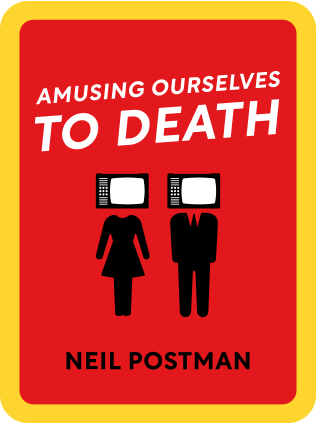

This article is an excerpt from the Shortform book guide to "Amusing Ourselves to Death" by Neil Postman. Shortform has the world's best summaries and analyses of books you should be reading.
Like this article? Sign up for a free trial here .
In what ways are form and content co-dependent? How are television and other forms of content hastening the death of our culture?
According to Neil Postman, the author of Amusing Ourselves to Death, we are allowing the form (television and other forms of media) to dictate the content of our public discourse. In essence, television is redefining public life, and by extension, our culture and society.
Here are some examples of how form dictates content and what it means for our culture.
Media Is a Metaphor for Reality
Throughout human history, the form or technology of communication has dictated what ideas we express and how we express them.
In early America, print culture defined the world as ordered, rational, understandable, and requiring citizen engagement. In contrast, beginning in the late 19th century, the burgeoning image-driven culture later dominated by television presented the world as chaotic, disconnected, distracting, and disempowering. As a result, we became fixated on whatever was most entertaining, rather than most valuable or important.
In replacing the Age of Typography or print, the Age of Television changed the content of our public discourse (what we talk about) by redefining every aspect of public life—politics, news, education, religion, and business—as entertainment or show business.
We’re in essence “amusing ourselves to death”—that is, hastening the death of our culture by accommodating ourselves to television’s way of defining things, without thinking about or even noticing what’s happening. That’s the power of form and content.
Form Dictates Content
Politicians of the 20th century quickly learned that the medium or form of communication dictates the message, and they accommodated themselves to television. In fact, our forms of communication throughout history have similarly dictated what was communicated and shaped the culture. Television is just the latest example.
For example, native Americans communicated with smoke signals, but the form—puffs of smoke—precluded complicated messages like a discussion of philosophy. (You can’t convey philosophy on television, either—its form of communicating in images rather than words requires more simplistic content.)
The telegraph was another medium whose form or design determined the information it delivered. The kind of information that Americans have come to think of as the “news of the day” didn’t exist until the telegraph was invented and delivered it.
The telegraph made it possible to move bits of disparate information lacking any context over long distances at incredible speed. Previously inaccessible information about fires, wars, and murders in far-flung places became part of local conversations and culture despite lacking local relevance. (Chapter 5 examines the rise of the telegraph in more detail.)
Today, we’ve adapted to receiving the “news of the day” in a fragmented form because television and other electronic media are designed to deliver it this way. Cultures that delivered information over long distances by smoke signals didn’t have “news of the day.”
The Medium as Metaphor
Communications theorist Marshall McLuhan originated the idea that the dominant medium available to a culture largely determines its public discourse. He observed that every new medium—painting, hieroglyphs, the alphabet, the printing press, telegraph, and television—recreated discourse by changing people’s way of thinking. For instance, the development of the alphabet and writing shifted the mode of perceiving language from hearing to reading.
McLuhan argued that “the medium is the message”—that form (like smoke signals) dictates content. However, media forms are even more powerful than McLuhan realized. It’s more appropriate to say “the medium is the metaphor.” The dominant medium becomes a society’s metaphor for reality. As we’ll see, the medium—in our case, television—tells us we should view the world as disjointed entertainment. Yet we’re largely unaware of television’s role in defining our reality.
Every tool or technology we create changes our thinking in some way beyond the tool’s actual function. When the clock enabled us to measure time moment by moment, time became fathomable rather than a mysterious force controlled by God or nature. Similarly, the invention of eyeglasses suggested that the human body could be improved and the effects of aging countered.
The shift from typography/writing to television as the dominant medium of our era is transforming our way of thinking and the content of our culture by elevating entertainment as the goal.

———End of Preview———
Like what you just read? Read the rest of the world's best book summary and analysis of Neil Postman's "Amusing Ourselves to Death" at Shortform .
Here's what you'll find in our full Amusing Ourselves to Death summary :
- How television reshaped our culture and trivialized public life by turning it into entertainment
- Why America is moving towards a dystopian, Huxleyan future
- What you can do to gain control over the technology in your life






